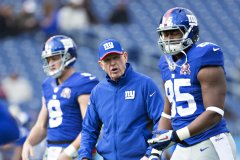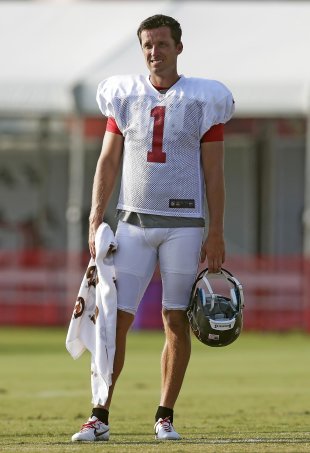Football is a dangerous sport and every Sunday brings physical risk, but once again the sport is facing a serious health hazard away from the field.

Daniel Fells (R) is out for the season for the Giants. (Getty Images)
NFL Network reported Sunday that New York Giants tight end Daniel Fells is fighting a case of MRSA so severe that he might need his foot amputated. And that may not be the worst of it, as there is concern that the illness may have advanced to his bone and his bloodstream. Fells has already undergone a reported five surgeries, and may need more in the effort to stave off the infection.
After a week of pain and fever following a cortisone shot, Fells’ wife took him to the emergency room on Oct. 2, where MRSA was found in his injured ankle. Had he waited longer, the infection would have had more time to spread.
Fells tweeted on Sunday evening:
“MRSA is the bane of medicine right now,” says Derek Ochiai, a Maryland-based surgeon who specializes in the treatment of upper and lower extremities.
The problem is two-fold: In spotting it, and in treating it. It’s hard to differentiate MRSA from another ailment at first, and then it’s resistant to antibiotics.
“It’s a big problem,” Ochiai says. “It’s resistant to all the penicillins you would normally use to treat. Very aggressive bacteria, very hearty, very difficult to eradicate.”
The NFL implemented a protocol for dealing with MRSA after three Tampa Bay Buccaneers – Carl Nicks, Lawrence Tynes and Johnthan Banks – got the infection in 2013, and the Giants are now abiding by it after Fells’ diagnosis.
There is no current sign of any MRSA in any other Giants player, but Banks’ case emerged weeks after Tynes’ did. Everyone is hoping Fells immediately recovers, but the problem with MRSA is the troubles it brings often get worse.
Any lost time can lead to a crisis for a football franchise, as bacteria can spread in a football locker room without anyone knowing about it. “MRSA likes warm places, and it’s spread by contact, and sharing equipment,” says Jeanine Thomas, founder of the MRSA Survivors Network. “It’s a perfect environment, especially if equipment isn’t sanitized after every use.”
The Giants say they are taking the situation seriously, and released a statement reading in part: “We are working with infectious disease specialists, and we have defined protocols that we are following in consultation with the Duke Infection Control Outreach Network and local infectious disease specialists.”
Other franchises to confront MRSA include the Cleveland Browns and Washington Redskins.
Tynes, a kicker, contracted it after what he thought would be a routine procedure on an ingrown toenail. He says the Bucs set up the appointment and advised him to rehab at their facility. Tynes’ toe did not heal normally and he became feverish. He was diagnosed with MRSA and underwent three surgeries. He never played again after getting the infection, and now he’s suing the franchise for $20 million.
“He feels cheated by this whole experience,” said Tynes’ lawyer, Stephen Rosenthal, “and he wants to get to the bottom of it.”
That may happen soon, as a judge ruled in September that the Bucs could not move the case to federal court. That means Florida court, and discovery that should shed more light on what happened to the Bucs who contracted MRSA.
“We’re confident that when we have full access to discovery, we can make a good case,” Tynes’ lawyer said.
The Bucs have not publicly responded to the lawsuit.
The fallout has gone well past Tynes. The MRSA outbreak permanently disrupted the Bucs’ 2013 season. Tampa made wholesale changes after a difficult season, firing general manager Mark Domenik and head coach Greg Schiano and even changing the team uniforms. Banks returned, but Nicks did not. He’s now out of football.
- Sports & Recreation
- Health
- Daniel Fells
- New York Giants
- Lawrence Tynes
- MRSA
- NFL Network




